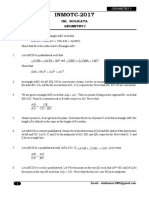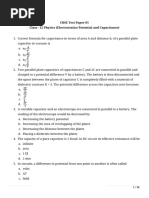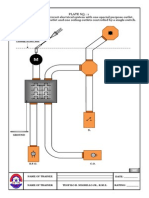Resistor Cube Problem PDF
Uploaded by
Cullado Christian JosephResistor Cube Problem PDF
Uploaded by
Cullado Christian JosephPage 1 of 8
The Resistor Cube Problem
By: David Randall - VK4TDR
1 July 2006
Its a relaxing Saturday afternoon at your local amateur radio club and youre busy
discussing the finer points of antenna theory with some friends. The next thing you know a
fellow amateur interrupts you by throwing you a small neatly soldered resistor cube. This
person then challenges you to find the resistance between any two diagonally opposite
corners without using an ohmmeter.
Problem: The resistor cube consists of 12 resistors, each having a value of exactly 1 ohm.
What is the total resistance between the two diagonally opposite corners
labeled A and H on the diagram below?
Figure 1
Solution: There are many different approaches to solving this problem and I would
encourage you to have a go at solving it for yourself before looking at the
solutions I have presented.
On the pages that follow I show two very different methods for solving this
particular problem. The first method, which is a more generic method, uses
loop equations and simultaneous equations to solve the problem. The second
method is a very elegant solution and shows what can be achieved by using a
totally different approach. It makes use of simple logical reasoning with some
ohms law thrown in.
Page 2 of 8
Solution 1 Using Loop Equations
The basic steps for solving this problem using loop equations are:
1. Redraw the 3 dimensional resistive cube network in 2 dimensions.
2. Draw all the loop currents in a clockwise direction and identify them.
3. Write the equations for the voltage drops around each loop in turn.
4. Solve the equations to find the unknown currents using the method of simultaneous
equations.
Step 1 & 2: Draw the circuit in 2d and identify the loop currents.
Figure 2
Step 3: Write the voltage drop equations for each of the loops.
Loop i
1
(orange):
V =(
1
+
2
)R +
1
R +(
1
+
3
)R =>Multiply out the brackets.
=
1
R +
2
R +
1
R +
1
R +
3
R =>Because R =1 we can simplify to:
=
1
+
2
+
1
+
1
+
3
=>Collect like terms.
=3
1
+
2
+
3
Page 3 of 8
Loop i2 (purple):
V =(
1
+
2
)R +
2
R +(
2
+
5
)R =>Multiply out the brackets.
=
1
R +
2
R +
2
R +
2
R +
5
R =>Because R =1 we can simplify to:
=
1
+
2
+
2
+
2
+
5
=>Collect like terms.
=
1
+3
2
+
5
Loop i3 (red):
V =(
3
+
4
)R +
3
R +(
1
+
3
)R =>Multiply out the brackets.
=
3
R +
4
R +
3
R +
1
R +
3
R =>Because R =1 we can simplify to:
=
3
+
4
+
3
+
1
+
3
=>Collect like terms.
=
1
+3
3
+
4
Loop i4 (green):
V =(
3
+
4
)R +
4
R +(
4
+
6
)R =>Multiply out the brackets.
=
3
R +
4
R +
4
R +
4
R +
6
R =>Because R =1 we can simplify to:
=
3
+
4
+
4
+
4
+
6
=>Collect like terms.
=
3
+3
4
+
6
Loop i5 (pink):
V =(
5
+
6
)R +
5
R +(
5
+
2
)R =>Multiply out the brackets.
=
5
R +
6
R +
5
R +
5
R +
2
R =>Because R =1 we can simplify to:
=
5
+
6
+
5
+
5
+
2
=>Collect like terms.
=
2
+3
5
+
6
Loop i6 (blue):
V =(
5
+
6
)R +
6
R +(
4
+
6
)R =>Multiply out the brackets.
=
5
R +
6
R +
6
R +
4
R +
6
R =>Because R =1 we can simplify to:
=
5
+
6
+
6
+
6
+
4
=>Collect like terms.
=
4
+
5
+3
6
We now have six equations with six unknowns,
1
to
6
,
so we can
solve this problem using
the method of simultaneous equations. We begin by assigning some value of voltage to V
and then writing out the six equations.
Page 4 of 8
If we let the voltage V =1 Volt then the six equations are:
1 =3
1
+
2
+
3
1 =
1
+3
2
+
5
1 =
1
+3
3
+
4
1 =
3
+3
4
+
6
1 =
2
+3
5
+
6
1 =
4
+
5
+3
6
Now solving six simultaneous equations is not an easy task, but luckily for us this
particular problem allows us to reduce the number of equations involved. We can do this
because of the symmetry of the resistor cube network and the fact that all the resistors are
identical in value. If you look at the two-dimensional diagram in figure 2 you should be
able to see that the following currents must be equal.
1
=
6
2
=
5
3
=
4
Substituting the currents
4
,
5
and
6
with their equivalents
3
,
2
and
1
in the above six
equations yields:
1 =3
1
+
2
+
3
1 =
1
+3
2
+
2
1 =
1
+3
3
+
3
1 =
3
+3
3
+
1
1 =
2
+3
2
+
1
1 =
3
+
2
+3
1
Notice that due to the symmetry we have pairs of identical equations, this is good news as
it now means that we only have 3 equations with 3 unknowns to solve.
So, the 3 equations are:
1 =3
1
+
2
+
3
1 =
1
+3
2
+
2
1 =
1
+3
3
+
3
Page 5 of 8
If you look carefully at the 3 above equations you will notice that they can be further
simplified by collecting like terms.
1 =3
1
+
2
+
3
1 =
1
+4
2
1 =
1
+4
3
We can now begin to solve the currents
1
,
2
and
3
using the method of simultaneous
equations.
1 =3
1
+
2
+
3
(Equation E1)
1 =
1
+4
2
(Equation E2)
1 =
1
+4
3
(Equation E3)
Multiply Equation E1 by 4.
(E1) x 4 => 4 =12
1
+4
2
+
3
(Equation E4)
Subtract equation E2 from equation E4 to cancel the I2 terms.
(E4) - (E2) => 3 =11
1
+4
3
(Equation E5)
Subtract equation E3 from equation E5 to cancel the I3 terms. Then solve for I1.
(E5) - (E3) => 2 =10
1
2 =101
1 =2 / 10
1 =1/5A
Solve for I2 by substituting I1 into equation (E2)
1 =1/5 +4
2
2
=(1 1/5) / 4
2
=1/5A
Solve for I3 by substituting I1 into equation (E3)
1 =1/5 +4
3
3
=(1 1/5) / 4
3
=1/5A
We have now shown that the currents
1,
2
and
3
are equal and have a value of 1/5A. But
what about the other three currents
4,
5
and
6
? Well remember earlier we said that
because of the symmetry of the cube, the currents
1
=
6
,
2
=
5
and
3
=
4.
Therefore we
can conclude that all of the currents
1
through to
6
are the same and equal to 1/5A.
Page 6 of 8
Therefore the total current flowing into the circuit is:
TOTAL
=
1
+
2
+
3
+
4
+
5
+
6
=1/5 +1/5 +1/5 +1/5 +1/5 +1/5
=6/5A
We now use Ohms law to determine the total resistance of the cube resistor network.
R
T
=E /
T
=1V / (6/5A)
=5/6
The total resistance between the two diagonally opposite corners labelled A and H on the
diagram in figure 1 is 5/6 ohms.
Page 7 of 8
Solution 2 Using Logical Reasoning
The basic steps needed to solve this problem are:
1. Assume a current of 1 ampere is flowing into the circuit.
2. Determine the current flowing in each branch of the network.
3. Determine the voltage dropped across each resistor in the network and so
determine the applied voltage V.
4. Use ohms law to calculate the total resistance of the network.
Step 1:
The first step towards solving the total resistance of the cube is to assume that a current of
1A is flowing into the resistor cube network. The diagram below shows 1A entering the
network at junction A and 1A leaving it at H.
Figure 3
Step 2:
Now because of the symmetry of the resistor cube network, the 1A current flowing into
junction A must divide evenly between the 3 branches AE, AC and AB so each branch will
have 1/3A flowing in it.
Now the currents in AE, AC and AB each divide evenly into two further branches at
junctions E, C and B. This means we have 1/6A flowing through the resistors in branches
BD, BF, EG, EF and CD, CG, shown in green above.
The six 1/6A branches then recombine in pairs at junctions D, F and G so we have 1/3A
flowing in branches DH, FH and GH.
These three branches then recombine at junction H and 1A flows out of the resistor cube
network.
Page 8 of 8
Step 3:
We have now determined the value of the current flowing in each branch of the cube
network. We also know that each resistor has a value of 1 ohm, therefore we can
calculate the voltage dropped across each resistor in the network. All we then have to do
is sum the voltage drops of any single path between A and H.
Using the path A, B, D, H we see that:
V =(1/3A)R +(1/6A)R +(1/3A)R
=(1/3A x 1) +(1/6A x 1) +(1/3A x1)
=1/3 +1/6 +1/3
=5/6V
The applied voltage V is equal to 5/6 volts.
Step 4:
We now know the applied voltage V along with the value of the current flowing into the
circuit, so we can use ohms law to calculate the total resistance of the R
T
.
R
T
=V /
=(5/6V) / 1A
=5/6
The total resistance between the two diagonally opposite corners labelled A and H on the
diagram in figure 1 is 5/6 ohms.
You might also like
- Ferucio Laurențiu Țiplea - Fundamentele Algebrice Ale Programarii (Algebraic Foundations of Computer Science) (2021)No ratings yetFerucio Laurențiu Țiplea - Fundamentele Algebrice Ale Programarii (Algebraic Foundations of Computer Science) (2021)302 pages
- Fundamentals of Physics, 8th Edition Halliday, Resnick, WalkerNo ratings yetFundamentals of Physics, 8th Edition Halliday, Resnick, Walker5 pages
- The Number of Homomorphisms From ZN To ZMNo ratings yetThe Number of Homomorphisms From ZN To ZM3 pages
- Tabel Al Derivatelor Functiilor ElementareNo ratings yetTabel Al Derivatelor Functiilor Elementare1 page
- Elastic Crack Growth in Finite Elements With Minimal Remeshing-Belytschko and Black-1999No ratings yetElastic Crack Growth in Finite Elements With Minimal Remeshing-Belytschko and Black-199920 pages
- 11th Maths Vol1 EM WWW - Tntextbooks.inNo ratings yet11th Maths Vol1 EM WWW - Tntextbooks.in320 pages
- Class 12 Physics Competency Based Question Bank 3 Current ElectricityNo ratings yetClass 12 Physics Competency Based Question Bank 3 Current Electricity90 pages
- WBJEE 2012 Physics and Chemistry Question Paper With Solution100% (1)WBJEE 2012 Physics and Chemistry Question Paper With Solution53 pages
- RMM TRIANGLE MARATHON 1301 1400 - CompressedNo ratings yetRMM TRIANGLE MARATHON 1301 1400 - Compressed138 pages
- Analytic Functions: Book: A First Course in Complex Analysis With Applications by Dennis G. Zill and100% (1)Analytic Functions: Book: A First Course in Complex Analysis With Applications by Dennis G. Zill and13 pages
- Rigid Body Dynamics Type 2 PART 2 of 3 ENGNo ratings yetRigid Body Dynamics Type 2 PART 2 of 3 ENG21 pages
- Applied Mathematics Sem-2 Book Join "All India Polytechnic AICTE" Telegram GroupNo ratings yetApplied Mathematics Sem-2 Book Join "All India Polytechnic AICTE" Telegram Group5 pages
- Thermal Expansion, Thermometry and Calorimetry - TheoryNo ratings yetThermal Expansion, Thermometry and Calorimetry - Theory30 pages
- Facultatea de Arhitectura Navala - Orar Anul Ii (Sem. 1) : INN 2121 2122 2123 A B A B A BNo ratings yetFacultatea de Arhitectura Navala - Orar Anul Ii (Sem. 1) : INN 2121 2122 2123 A B A B A B1 page
- Physics: Sri Chaitanya IIT Academy, IndiaNo ratings yetPhysics: Sri Chaitanya IIT Academy, India10 pages
- JEE Main 2019 Answer Key Solutions January 12 by Aakash PDFNo ratings yetJEE Main 2019 Answer Key Solutions January 12 by Aakash PDF56 pages
- Rank of A Word - Jee Mains Most Used Tricks-1No ratings yetRank of A Word - Jee Mains Most Used Tricks-130 pages
- AMRITA VISHWA VIDYAPEETHAM - MCA Entrance Examination Sample Paper100% (1)AMRITA VISHWA VIDYAPEETHAM - MCA Entrance Examination Sample Paper6 pages
- Worksheet - 18: Subject: Physics Class: VIII (Techno) Topic: Optics Concept - IVNo ratings yetWorksheet - 18: Subject: Physics Class: VIII (Techno) Topic: Optics Concept - IV1 page
- Physics: SN Chapter 2006 2007 2008 2009 2010 2011 2012 2013 2016 2017 2018No ratings yetPhysics: SN Chapter 2006 2007 2008 2009 2010 2011 2012 2013 2016 2017 20183 pages
- 28-12-19 SR - Icon All GTM-5 CODE-A Question PaperNo ratings yet28-12-19 SR - Icon All GTM-5 CODE-A Question Paper25 pages
- ENG1013 Week 6 Electrical Problem Sheet SolutionsNo ratings yetENG1013 Week 6 Electrical Problem Sheet Solutions16 pages
- Digital Terrestrial Migration in The Philippines Part 1 - Melvin AcostaNo ratings yetDigital Terrestrial Migration in The Philippines Part 1 - Melvin Acosta10 pages
- If You Want The Circuit To Be in Stable MannerNo ratings yetIf You Want The Circuit To Be in Stable Manner2 pages































































